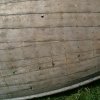This is my first post. It finally time to repair my 14 foot Pennyan cartopper, LXH51320. Once pristine over the years it's had a few accidents so in rough shape. While looking into what's involved a friend gave me his 12' cartopper in pretty bad shape. The plan is to attempt fixing the 12' and get some experience before working on mine.
Note: the 12' has severely rotted gunnel's, broken ribs and may need a strake or two replaced (not positive about the strakes).
1. The 12' had been fiberglassed many years ago and job very well done. A section of fiberglass at the transom top has lifted and cleanly, about 8 inches along the top and extending down 4-6 inches. That could be repaired and the boat left in fiberglass. I'm not sure if the fiberglass job has penetrated the wood. The question is would it be possible to strip the whole boat of fiberglass or will doing that destroy the strakes?
2. Is it possible to replace a rib with the hull fiberglassed? If yes, how?
3. The 14' has it's canvas removed. What's the best way to remove ribs on that?
4. The 12' was spar varnished 10-15 years ago and now crinkled and in bad shape. What's the best method of removing the old varnish and original finish. It would be good if some bio-degradable solvent was available in the strength needed. Anyone have any suggestions for what can be used?
The 14' is still in pretty good original shape but the interior could use a refinish also. What would be best to use on the 14'.
I'll try and post some pictures later.
Thanks,
David
Note: the 12' has severely rotted gunnel's, broken ribs and may need a strake or two replaced (not positive about the strakes).
1. The 12' had been fiberglassed many years ago and job very well done. A section of fiberglass at the transom top has lifted and cleanly, about 8 inches along the top and extending down 4-6 inches. That could be repaired and the boat left in fiberglass. I'm not sure if the fiberglass job has penetrated the wood. The question is would it be possible to strip the whole boat of fiberglass or will doing that destroy the strakes?
2. Is it possible to replace a rib with the hull fiberglassed? If yes, how?
3. The 14' has it's canvas removed. What's the best way to remove ribs on that?
4. The 12' was spar varnished 10-15 years ago and now crinkled and in bad shape. What's the best method of removing the old varnish and original finish. It would be good if some bio-degradable solvent was available in the strength needed. Anyone have any suggestions for what can be used?
The 14' is still in pretty good original shape but the interior could use a refinish also. What would be best to use on the 14'.
I'll try and post some pictures later.
Thanks,
David
































